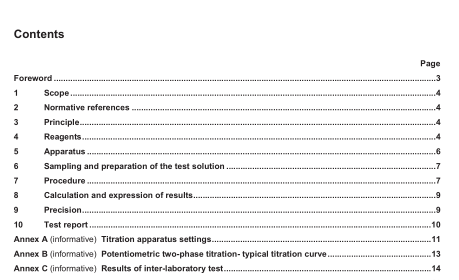EN 14669:2005 – Surface active agents – Determination of anionic surface active agents and soaps in detergents and cleansers – Potentiometric two-phase titration method

1 Scope This European Standard specifies a method for the determination of the content of anionic surface active agents and soaps in detergents and cleansers, defined as being the amount of anionic surface active agents expressed in millimoles per 100 g of product.
NOTE 1 The applicability in products different that those tested should be checked in each particular case.
NOTE 2 In comparison to usual laboratory two-phase titration with visual endpoint determination (see ISO 2271), potentiometric titration offers the advantage of automation; operator-dependent differences in recognising the equivalence point can be neglected, and a non-critical solvent replaces the toxicologically critical chloroform.
2 Normative references
The following referenced documents are indispensable for the application of this document. For dated references, only the edition cited applies. For undated references, the latest edition of the referenced document (including any amendments) applies.
EN 14670, Surface active agents – Sodium dodecyl sulfate – Analytical method.
EN ISO 3696, Water for analytical laboratory use – Specification and test methods (ISO 3696:1987).
ISO 607, Surface active agents and detergents – Methods of sample division.
3 Principle
Anionic surface active agents and soaps are combined with cationic surface active agents to form water-insoluble ion pairs which are immediately extracted into a water immiscible organic solvent. This fundamental reaction is the basis for the titration of equivalents of ionic surface active agents with an oppositely charged surface active agent standard volumetric solution in the two-phase titration. This procedure is supported by intensively stirring the two-phase mixture of aqueous solution and organic phase.
The potential, which is formed in the emulsion during the titration, is recorded with the help of a special solvent- resistant surface active agent-sensitive electrode in combination with a silver/silver chloride reference electrode against the amount of titrant added. The equivalence point of the added cationic surface active agent corresponds to that one of the test solution at the inflection point of the titration curve (Annex B).
The titration is carried out twice, once under acidic conditions for the determination of the anionic surface active agents and then under alkaline conditions in order to determine the sum of soaps and anionic surface active agents. The soap concentration is calculated from the difference of the titrant consumptions.
4 Reagents WARNING — Your attention is drawn to the regulations covering the handling of hazardous substances. Technical, organisational and personal protection measures should be observed. During the analysis, unless otherwise specified, use only reagents of recognised analytical grade that have been checked in advance as to not interfere with the analytical results.
4.1 Water, complying with grade 3 as defined in EN ISO 3696. NOTE If the water is purified via ion-exchange resins, ensure that no cationic or anionic species from the resins cause interference.
EN 14669:2005 – Surface active agents – Determination of anionic surface active agents and soaps in detergents and cleansers – Potentiometric two-phase titration method